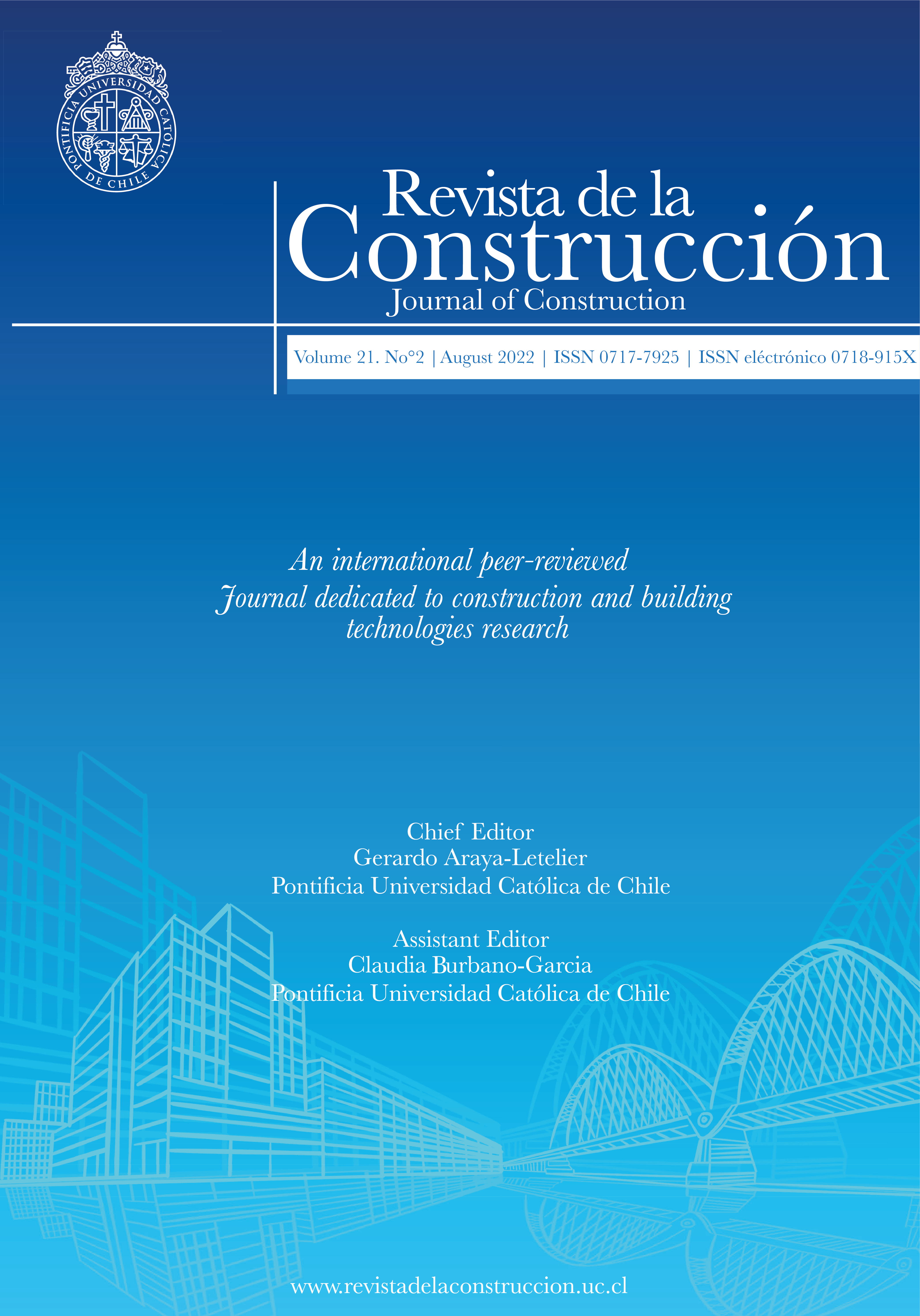Investigation on behavior and seismic performance of reduced beam sections
DOI:
https://doi.org/10.7764/RDLC.21.2.427Keywords:
Cycling loading, European steel shapes, Moment connection, Reduced beam section, Steel moment resisting frame.Abstract
Engineers prefer reduced beam section (RBS) connections in steel moment frames built in earthquake zones due to their many benefits. The RBS shape design significantly affects joint behavior. This paper examines the effect of RBS geometry on joint behavior and seismic performance using ANSYS finite element analysis software. RBS connections are investigated using European profiles and steel grades due to the limited number of studies using European profiles in the literature. The simulation study is carried out in three stages. In the first stage, an experimental study in the literature is simulated, and the reliability of the created finite element model is checked. In the second stage, geometric changes are made to the verified numerical model, and the obtained new models are examined under monotonic loading to observe the effect of RBS geometry on moment-rotation behavior. In the third stage, the effect of the change in the RBS geometry on the seismic performance is investigated under cyclic loading. As a result of the study, the effects of various changes made in the RBS geometry on the joint behavior and seismic performance are presented graphically. By using the results of the analysis under monotonic loading, the regression analysis is carried out, and the formulas giving the elastic-plastic stiffness, elastic moment capacity, and elastic rotation angle of the support are derived. Besides, simulation models show that the RBS joints' seismic performance met the minimum criteria specified in the earthquake code (AISC/ANSI 341-16) when European steel profiles and quality are applied.
References
ANSI/AISC 341-16. Seismic provisions for structural steel buildings, 11 Construction, American Institute of Steel § (2016). Retrieved from https://www.aisc.org/globalassets/aisc/publications/standards/seismic-provisions-for-structural-steel-buildings-ansi-aisc-341-16.pdf
ANSI/AISC 358-16. Prequalified connections for pecial and intermediate steel moment frames for seismic applications. , American Institute of Steel Construction § (2016). Retrieved from https://www.aisc.org/globalassets/aisc/publications/standards/A358-16W.pdf
ANSYS. (2018). Theory Reference for the Mechanical APDL and Mechanical Applications. After Adoption. Canonsburg, Pennsylvania, U.S.A.: SAS IP, Inc. Retrieved from https://www.ansys.com/academic/students Retrieved from https://www.ansys.com/academic/students
Chen, C.-C., Chen, S.-W., Chung, M.-D., & Lin, M.-C. (2005). Cyclic behaviour of unreinforced and rib-reinforced moment connections. Journal of Constructional Steel Research, 61(1), 1–21. https://doi.org/10.1016/j.jcsr.2004.06.005 Retrieved from https://linkinghub.elsevier.com/retrieve/pii/S0143974X04000951
Crisan, A., & Dubina, D. (2016). Bending–shear interaction in short coupling steel beams with reduced beam section. Journal of Construction-al Steel Research, 122, 190–197. https://doi.org/10.1016/j.jcsr.2016.03.020 Retrieved from http://dx.doi.org/10.1016/j.jcsr.2016.03.020
Datafit 9.0. (2014). Datafit. Oakdale,Canada.
Dis, M. O., Anagnostou, E., & Mei, Y. (2018). Using high-resolution satellite precipitation for flood frequency analysis: case study over the Connecticut River Basin. Journal of Flood Risk Management, 11(November 2017), S514–S526. https://doi.org/10.1111/jfr3.12250 Re-trieved from http://doi.wiley.com/10.1111/jfr3.12250
Ermeydan, İ. (2019). Investigation performance of steel frames with reduced beam section under cyclic loading. Kahramanmaraş Sütçü İmam University, Graduate School of Natural and Applied Sciences,Kahramanmaraş.
Karip, C. (2014). Comparative performance assessments of steel frames with reduced beam section (rbs) under earthquake loads. İstanbul Technical University, Science Institute, İstanbul.
Li, R., Samali, B., Tao, Z., & Kamrul Hassan, M. (2017). Cyclic behaviour of composite joints with reduced beam sections. Engineering Struc-tures, 136, 329–344. https://doi.org/10.1016/j.engstruct.2017.01.025 Retrieved from http://dx.doi.org/10.1016/j.engstruct.2017.01.025
Morshedi, M. A., Dolatshahi, K. M., & Maleki, S. (2017). Double reduced beam section connection. Journal of Constructional Steel Research, 138, 283–297. https://doi.org/10.1016/j.jcsr.2017.07.013 Retrieved from https://doi.org/10.1016/j.jcsr.2017.07.013
Nogueiro, P., Simões Da Silva, L., Bento, R., & Simões, R. (2006). Experimental behaviour of standardised european end-plate beam-to-column steel joints under arbitrary cyclic loading. Proceedings of the International Colloquium on Stability and Ductility of Steel Struc-tures, SDSS 2006, (February), 951–960.
Oh, K., Lee, K., Chen, L., Hong, S.-B., & Yang, Y. (2015). Seismic performance evaluation of weak axis column-tree moment connections with reduced beam section. Journal of Constructional Steel Research, 105, 28–38. https://doi.org/10.1016/j.jcsr.2014.10.005 Retrieved from http://dx.doi.org/10.1016/j.jcsr.2014.10.005
Ohsaki, M., Tagawa, H., & Pan, P. (2009). Shape optimization of reduced beam section under cyclic loads. Journal of Constructional Steel Research, 65(7), 1511–1519. https://doi.org/10.1016/j.jcsr.2009.03.001 Retrieved from https://linkinghub.elsevier.com/retrieve/pii/S0143974X09000558
Pachoumis, D. T., Galoussis, E. G., Kalfas, C. N., & Efthimiou, I. Z. (2010). Cyclic performance of steel moment-resisting connections with reduced beam sections - experimental analysis and finite element model simulation. Engineering Structures, 32(9), 2683–2692. https://doi.org/10.1016/j.engstruct.2010.04.038 Retrieved from http://dx.doi.org/10.1016/j.engstruct.2010.04.038
Rahnavard, R., Hassanipour, A., & Siahpolo, N. (2015). Analytical study on new types of reduced beam section moment connections affect-ing cyclic behavior. Case Studies in Structural Engineering, 3, 33–51. https://doi.org/10.1016/j.csse.2015.03.001 Retrieved from http://dx.doi.org/10.1016/j.csse.2015.03.001
Sofias, C. E., Kalfas, C. N., & Pachoumis, D. T. (2014). Experimental and FEM analysis of reduced beam section moment endplate connec-tions under cyclic loading. Engineering Structures, 59, 320–329. https://doi.org/10.1016/j.engstruct.2013.11.010 Retrieved from http://dx.doi.org/10.1016/j.engstruct.2013.11.010
Swati, A. K., & Gaurang, V. (2014). Study of steel moment connection with and without reduced beam section. Case Studies in Structural Engineering, 1(1), 26–31. https://doi.org/10.1016/j.csse.2014.04.001 Retrieved from https://linkinghub.elsevier.com/retrieve/pii/S2214399814000058
Tezer, Ö. (2005). Reduced beam section beam-column connections. Turkey Engineering News, 54–59.
Downloads
Published
Versions
- 2022-09-29 (3)
- 2022-08-31 (2)
- 2022-08-31 (1)
How to Cite
Issue
Section
License
Copyright (c) 2022 İbrahim Ermeydan, Alirıza İlker Akgönen

This work is licensed under a Creative Commons Attribution-NonCommercial-NoDerivatives 4.0 International License.





